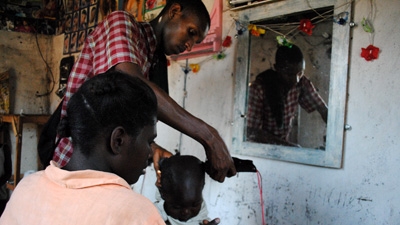BUJUMBURA, September 12, 2012 – Burundi has 38 megawatts of electricity for nine million inhabitants, a situation that has led to frequent power outages and complaints from every corner of the country about the distribution of the electricity supply.
A load shedding system causes electricity to be deliberately shut down in different parts of the region at various times. Welders, hairdressers and owners of cybercafés and other small businesses seem to be the worst affected by these rolling blackouts.
Issa Bahati is a welder who lives in the urban commune of Buyenzi. According to him, the residents of this working class neighborhood, populated primarily by small tradesmen, are now facing major difficulty.
“At times we have no electricity for two days,” he said. “How are we going to feed our families seeing that we make our living as welders?” Lack of electricity means that a job that should be finished in three days now takes two weeks, Bahati said, angering customers because the work is done too slowly.
Thanks to the World Bank’s involvement, there is hope for tradesmen like Bahati. Under the Burundi Multisectoral Water and Electricity Infrastructure Project, the World Bank’s investments are focused on the rehabilitation of the infrastructure of the main electricity grid, as well as financial support for optimal use of existing thermal electricity generation capacity, combined with energy demand management strategies.
Désiré Mugisha operates a hairdressing salon in the urban commune of Kamenge. Lack of electricity greatly affects his business.
“We often go for two days without electricity,” said the father of three. “During all that time, you are idle. Unfortunately, you have to eat even though you haven’t produced anything.”
Rosette Niyonzima, also from the urban commune of Kamenge, says that the power outages make it virtually impossible to run a milk business because she only has electricity for a few hours.
“I’ve already lost several cans of spoiled milk,” Niyonzima said. “Each can contains fifty liters and costs 60,000 Burundian francs.”
As a result of this lack of electricity, most Burundians use candles to light inside their homes. However, these candles also create problems, because they often cause fires.
Supply and Demand Gap and the Electricity Crisis of 2009
Burundi has been experiencing a severe electricity crisis since 2009, which has led to large scale and systematic load shedding, with serious effects on the economic recovery of a post-conflict country.
The rapid increase in the supply deficit is as a result of a combination of several factors; the lack of investment in the country’s hydroelectric power plants and lack of electricity production over the past 15 years, the rapid increase in electricity demand around the capital Bujumbura with the return to peace, low rainfall over the past three years, the degradation of the catchment area upstream from the main hydroelectric power plants due to deforestation and increased land use during the conflict years, major technical and commercial losses on the electricity grid and the lack of financial resources to operate the existing thermal power plant.
The electricity shortfall at times is approximately 40-50% of current peak period demand. The government responded to the crisis by introducing load shedding, accelerating reforestation in the main power harnessing zones for the hydroelectric power plant, and, above all, by using International Development Association (IDA) funds to purchase fuel to operate the 5.5 MW thermal power plant in Bujumbura.
World Bank Support for Solutions
The Burundi Multisectoral Water and Electricity Infrastructure Project also supports feasibility studies for renewable hydroelectric power plants. This has prepared the government to request financing from investors. These studies were a precondition. As a result of the World Bank’s involvement, about ten sites capable of producing between five and 30 megawatts each have already been identified.
Discussions about the Jiji and Mulembwe dams, which are going to produce 50 megawatts, are currently underway and the World Bank is ready to co-finance the development of these two sites, in partnership with the European Investment Bank. The production of hydropower provides a credible low-cost alternative, which allows for an increase in a share of the projected supply, in the medium term, before major hydropower developments like Kabu 16, Rusizi III, and the Rusumo waterfalls become operational.
An Emergency Project for the Electricity Sector [Projet d’Urgence pour le Secteur de l’Electricité PURSE] also started its activities in 2011. This was made possible with the implementation of a three-year financing agreement of US$15.4 million on February 23, 2011.
This project will facilitate the expansion of the Bujumbura thermal power plant, as well as the rehabilitation of the hydroelectric power plants and the electricity transmission and distribution grid. The purchase of pre-payment meters, as well as fuel for the thermal power plant and management of the project, will also be a priority.

